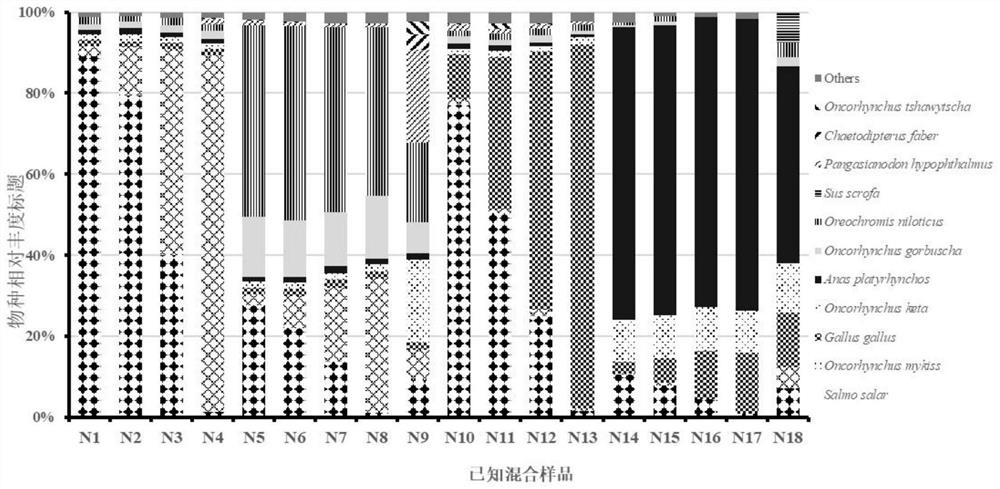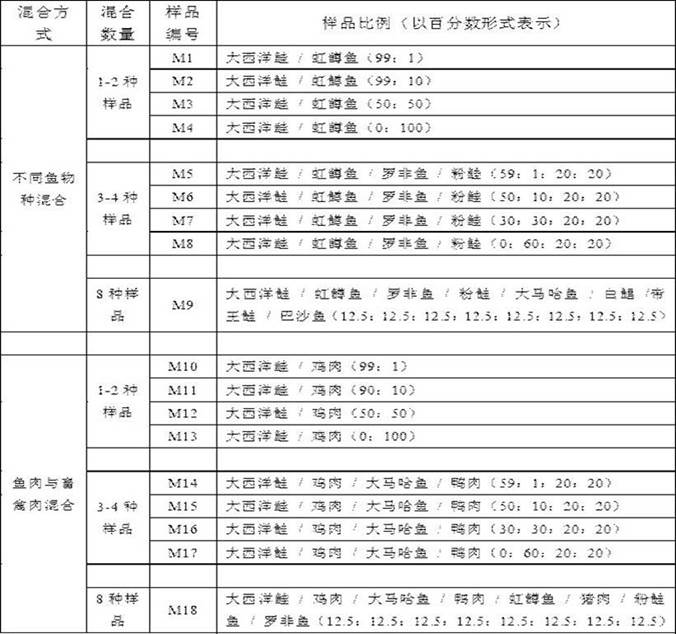Method for identifying animal-derived components in salmonidae fish product based on high-throughput sequencing
A high-throughput technology for fish products, applied in biochemical equipment and methods, microbial measurement/inspection, etc., can solve the problems of difficult separation of organisms, complex components, and difficult detection, etc., to overcome the low efficiency or inability of PCR amplification Effects of amplification, process simplification and cost reduction
- Summary
- Abstract
- Description
- Claims
- Application Information
AI Technical Summary
Problems solved by technology
Method used
Image
Examples
Embodiment 1
[0026] In this example, the accuracy and sensitivity of the high-throughput sequencing technology in the identification of mixed species are evaluated through the following tests.
[0027] 1. Preparation of Mixed Salmonidae Samples
[0028] Each sample was dehydrated and dried in a freeze dryer and then ground into powder. Based on the sample mass, 9 fish samples of known origin and species were collected according to different proportions and methods (mixing of fish species and mixing of fish, livestock and poultry) Gradient blending was performed to prepare mixed samples (Table 1). At the same time, a minimum sample mixing ratio of 1% was set to evaluate the accuracy, detection throughput and sensitivity of high-throughput sequencing technology in terms of species characterization.
[0029] Table 1 Preparation scheme of mixed samples of salmonids
[0030]
[0031] 2. Sample Genomic DNA Extraction
[0032] The improved CTAB method was used to extract the genomic DNA of ...
Embodiment 2
[0046] In this example, the animal-derived species components in commercially available salmonid fish products were analyzed through the following tests.
[0047] 1. Experimental method
[0048] A total of 32 commercially available salmonid fish foods were collected from retailers, supermarkets and e-commerce platforms, basically covering the types of salmonid fish foods currently on the market. DNA was extracted, and the remainder was consistent with Example 1.
[0049] 2. Analysis of results
[0050] Twenty-nine (90.6%) of the 32 commercially available salmonids food products used "salmon" as the food name. The identification results found that the main species involved include Atlantic salmon ( S. salar ) and humpback salmon ( O. gorbuscha ); a small number of samples (7, 8) are marked with the common name of the species in addition to "salmon". Refer to the relevant introductions about salmonids in the books "Species and Distribution of Marine Life in China" and "Fis...
PUM
 Login to view more
Login to view more Abstract
Description
Claims
Application Information
 Login to view more
Login to view more - R&D Engineer
- R&D Manager
- IP Professional
- Industry Leading Data Capabilities
- Powerful AI technology
- Patent DNA Extraction
Browse by: Latest US Patents, China's latest patents, Technical Efficacy Thesaurus, Application Domain, Technology Topic.
© 2024 PatSnap. All rights reserved.Legal|Privacy policy|Modern Slavery Act Transparency Statement|Sitemap



